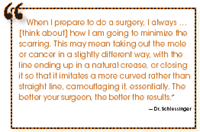- General Dermatology
- Eczema
- Chronic Hand Eczema
- Alopecia
- Aesthetics
- Vitiligo
- COVID-19
- Actinic Keratosis
- Precision Medicine and Biologics
- Rare Disease
- Wound Care
- Rosacea
- Psoriasis
- Psoriatic Arthritis
- Atopic Dermatitis
- Melasma
- NP and PA
- Skin Cancer
- Hidradenitis Suppurativa
- Drug Watch
- Pigmentary Disorders
- Acne
- Pediatric Dermatology
- Practice Management
- Prurigo Nodularis
Article
Get Scar Savvy
Use this expert advice to avoid or get rid of those embarrassing Â- and sometimes painful Â- imperfections.

Define it!
A natural part of the healing process, a scar forms as a result of new collagen fibers that reconnect damaged skin and create a "seam," or scar. Your options for getting rid of that scar may depend on the type of scar you have:
> Hairline scars are thin, flat and easy to hide.
> Hypertrophic scars are firm, raised accumulations of tissue that develop from an overabundance of collagen production, and sometimes grow larger than the wound. These scars can also be painful.
> Keloid scars are larger-sized hypertrophic scars.
Prevent it!
The most important tip is prevention. For acne patients, a qualified dermatologist can put together an effective skincare regimen with specific products that will help to prevent acne scarring. One of the current methods for treating acne is blue light LED therapy (see Beauty Smarts, page 10).

Another way to prevent? Ask your doctor about his or her suturing technique and strategies to minimize scarring before you undergo a surgical procedure.
Reduce it!

Hide it!
Have your dermatologist recommend a good makeup to conceal your scar. If it's a tummy tuck or c-section scar, consider innovative products that have entered the market such as ScarArt, a temporary tattoo, to mask those imperfections.





